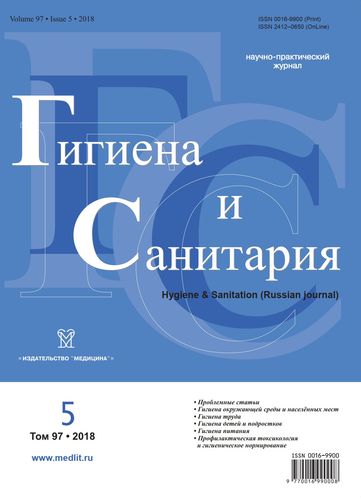The scientific backgrounds for the creation of a microecological cryopreservation of human resources
- Authors: Shenderov B.A.1, Yudin S.M.1, Shevyreva M.P.1,2, Boyko E.A.1,2
-
Affiliations:
- Centre for Strategic Planning and Management of Biomedical Health Risks
- I.M. Sechenov First Moscow State Medical University
- Issue: Vol 97, No 5 (2018)
- Pages: 396-398
- Section: PROBLEM-SOLVING ARTICLES
- Published: 20.10.2020
- URL: https://ruspoj.com/0016-9900/article/view/640308
- DOI: https://doi.org/10.47470/0016-9900-2018-97-5-396-398
- ID: 640308
Cite item
Full Text
Abstract
Anthropogenic physical, chemical, and biological impacts of objects on living organisms in the environment lead to profound structural and functional disorders primarily in the evolutionary current microbiocenosеs of a human. This is often accompanied by a deterioration in his health, an increase in the risk of infectious, chronic metabolic and mental diseases, which eventually can put a question for not only the preservation on our planet but also the entire existing diversity of living organisms. The development of cryobiotechnology and the creation of cryobanks of different directions is a common global trend in the development of Biological, Medical, Agricultural and Environmental Sciences. The advantage of the proposed technique of cryopreservation of symbiotic microbial associations is the storage of the biomaterials taken from the people will be carried out in an atmosphere of liquid nitrogen (-196°C) for the long-term storage. Fundamental and applied research on cryopreservation of microbiota of different human biotopes has a social orientation because they are directly related to human ecology and health of the nation.
About the authors
Boris A. Shenderov
Centre for Strategic Planning and Management of Biomedical Health Risks
Author for correspondence.
Email: shenderof@yandex.ru
MD, Ph.D., DSci., main researcher of the Laboratory of Sanitary Bacteriology and Parasitology of the Centre for Strategic Planning and Management of Biomedical Health Risks, Moscow, 119992, Russian Federation.
e-mail: shenderof@yandex.ru
Russian FederationS. M. Yudin
Centre for Strategic Planning and Management of Biomedical Health Risks
Email: noemail@neicon.ru
Russian Federation
M. P. Shevyreva
Centre for Strategic Planning and Management of Biomedical Health Risks; I.M. Sechenov First Moscow State Medical University
Email: shevirevamp@yandex.ru
Доктор мед. наук, проф., зам. директора по научной работе ФГБУ «ЦСП» Минздрава России.
e-mail: shevirevamp@yandex.ru
Russian FederationE. A. Boyko
Centre for Strategic Planning and Management of Biomedical Health Risks; I.M. Sechenov First Moscow State Medical University
Email: noemail@neicon.ru
Russian Federation
References
- Shenderov B.A. Microbial ecology of man and its role in maintaining health. Metamorphoses. 2014(3): 72-80.
- Khachatrian R., Khachatrian A. Bank of autochthonous strains of microorganisms and methods of its use for recovery of intestinal microbiocenosis of the men. US Patent 6428783 C12N 1/04, 2002
- Borody T., Warren E., Leis S., Surace R., Ashman O., Siarakas S. Bacteriotherapy using fecal flora: toping with human motions. J. Clin. Gastroenterol. 2004; 38(6): 475-83.
- Debast S.B, Bauer M.P, Kuijper E.J. On behalf of the Committee. European Society of Clinical Microbiology and Infectious Diseases: update for the treatment guidance document for Clostridium difficult infection. Clin Microbiol Infect. 2014; 20 (Supply 2): 1-26.
- Bakken J.S. Feces transplantation for recurrent Clostridium difficile infection: US experience and recommendations. Microb. Ecol. Health Dis. 2015, 26: 27657.
- Carlucci C., Petrof E.O., Allen-Vercoe E. Fecal Microbiota-based Therapeutics for Recurrent Clostridium difficile infection, Ulcerative Colitis and Obesity. EBioMedicine. 2016. https://doi.org/10.1016/J.ebiom.2016.09.029
- Hyun Ho Choi, Young-Seok Cho. Fecal Microbiota translation: Current Applications, Effectiveness, and Future Perspectives. Clin. Endosc. 2016; 49: 257-265.
- Nibali L., Henderson B. The Human Microbiota and Chronic Disease: Dysbiosis as a cause of Human Pathology. First Edition. 2016 John Wiley & Sons, Inc. New Jersey, USA, 520 pages.
- Fak F. The gut microbiota: a predisposing factor in vanity, diabetes and atherosclerosis. Chapter 23. In: The Human Microbiota and Chronic Disease: Dysbiosis as a cause of Human Pathology. First Edition. 2016. John Wiley & Sons, Inc. New Jersey, USA; 351-359.
- Lo Vecchio A., Guarino A. The microbiota as target for therapeutic intervention in pediatric intestinal diseases. Chapter 31. In: The Human Microbiota and Chronic Disease: Dysbiosis as a cause of Human Pathology. First Edition. 2016. John Wiley & Sons, Inc. New Jersey, USA; 483-496.
- Bruzzese E., Buccigrossi V., Ranucci G., Guarino A. Microbial therapy for cystic fibrosis. Chapter 32. In: The Human Microbiota and Chronic Disease: Dysbiosis as a cause of Human Pathology. First Edition. 2016. John Wiley & Sons, Inc. New Jersey, USA; 497-506.
- Kazerouni A., Burgess J., Burns L.J., Wein L.M. Optimal screening and donor management in a public stool bank. Microbiome 2015; 3: 75. doi: 10.1186/s40168-015-0140-3
- Shenderov B.A., gakhova E.N., kaurova S.A., Uteshev V.K., Shishova R.V. Cryobanks natural simbioticheskoi of microbial associations and their importance in medicine and biotechnology. Biophysics of living cells. 2014(10): 221-223.
- Bezrodny S.L., Shenderov B.A. Intestinal microbiota as a source of new biomarkers of aging. Journal of restorative medicine & rehabilitation. 2015(2): 40-47.
- Shenderov B.A. Microecological epigenetics of stress, diseases, health and longevity. Journal of restorative medicine & rehabilitation. 2016(1): 21-28.
Supplementary files









